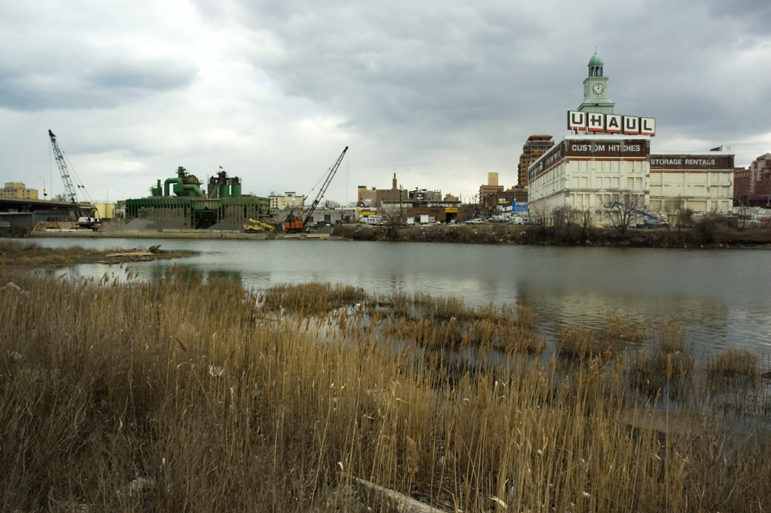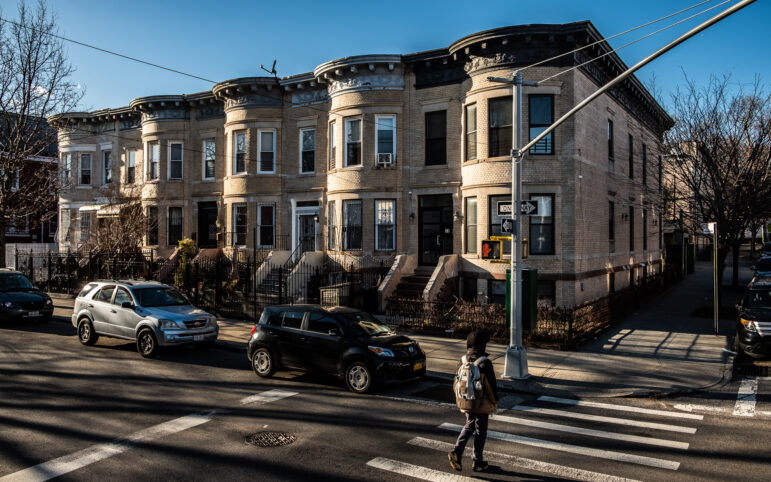
Timothy Vogel
The shoreline of Flushing Creek figured prominently in the Flushing West rezoning vision that was set aside two years ago.
A state designation that will fast track the clean-up of long-polluted sites and a waterway in Flushing could usher in waterfront redevelopment despite the 2016 withdrawal of a bid to rezone the neighborhood’s coast.
A full rezoning still seems off the table, however.
The Flushing Willets Point Corona LDC nominated the area for a state-funded Brownfield Opportunity Area (BOA) designation grant to address environmental issues on vacant or underutilized properties. The Cuomo administration approved the grant in June.
The BOA grant from the state will allow a clean up for those deteriorated sites and Flushing Creek. One of the grant’s requirements is for a nomination application to showcase economic development opportunities of the nominated area. The Flushing Willets Point Corona LDC hopes to turn the brownfield sites into an area for light industrial and mixed-use redevelopment, create open spaces and improve access to the waterfront site.
A brownfield is “a property, the expansion, redevelopment, or reuse of which may be complicated by the presence or potential presence of a hazardous substance, pollutant, or contaminant,” according to the United States Environmental Protection Agency website.
According to the state’s Office of Planning and Development’s website, the BOA applicant must put forth a revitalization strategy to promote redevelopment, including housing and businesses and enhanced environmental quality of the nominated area. Currently, New York has 47 BOA designations across the state.
In Flushing’s case, the BOA nomination application required a Nomination Study and Environmental Assessment Report (EAR) which included waterfront revitalization plans for the area–a former industrial area between downtown Flushing and the waterfront with 32 potential brownfields sites.
The study area comprises of a six-block area from Northern Boulevard to the north across to Roosevelt Avenue to the south, Prince Street to the east across to the Flushing Creek/Van Wyck Expressway to the west. It encompasses approximately 62 acres; street beds, undevelopable wetlands and a portion of Flushing Creek which includes approximately 32 acres underutilized commercial and light industrial property and a section of Downtown Flushing, from 35th Avenue to the north, Union Street to the east, Sanford Avenue/Long Island Rail Road to the south, and the Van Wyck Expressway to the west.
Last year, with the assistance of the Department of City Planning, the Flushing Willets Point Corona LDC completed the BOA application with a Nomination Study and Environmental Assessment Report.
Those plans were in line with the city’s postponed rezoning of the broader Flushing West area. The Flushing West rezoning plan, which included waterfront redevelopment, was tabled in 2016 amid concerns about infrastructure, transportation demands, affordable housing and waterfront access.
The BOA grant is estimated at $1.5 million will finance planning activities for the area. The waterfront plan aims to create a land-use strategy including a Special Flushing Waterfront District to enable an extension of Downtown Flushing for mixed-use redevelopment, open space and waterfront access, improvements to pedestrian and vehicular traffic and long-term improvement of water quality in Flushing Creek, according to the study.
Councilman Peter Koo is supportive of any clean up of brownfields and waterways of western Flushing as a priority for any future development, but he emphasized that any redevelopment must also address the area’s insufficient infrastructure, transportation options, and waterfront access, according to Koo’s spokesman Scott Sieber.
The Flushing Waterfront Revitalization Plan covers only a portion of the city’s original Flushing West rezoning plan. The Flushing rezoning plan would have applied to an 11-block area east of Flushing Creek and west of Flushing Prince Street. That area includes a mix of vacant, underused and industrial sites, especially close to the waterfront, as well as new high-end commercial and condominium buildings on the eastern side. The rezoning would have increased allowable density while requiring a percentage of income-targeted housing under the city’s mandatory inclusionary housing policy.
Koo requested the rezoning be withdrawn due to a variety of concerns related to the area’s already overtaxed infrastructure, including the DCP’s own concerns about the feasibility of an upzoning in light of height regulations reflecting the area’s proximity to LaGuardia airport.
This week, Koo’s office did emphasize that a large-scale rezoning such as Flushing West would not see their support anytime soon. Ultimately, Koo would like other Flushing Creek properties to create a seamless waterfront access plan with a commitment to clean up Flushing Creek, according to his spokesman Sieber.
At the time the rezoning was withdrawn two years ago, the Flushing Rezoning Community Alliance, a coalition of residents, faith leaders and others who were organizing around the plan, had mixed feelings about the rezoning; they expressed concerns about the lack of deep affordability and anti-displacement protections but also did not want to lose out on the benefits of city investments and income-targeted housing.
“[Flushing Willets Point Corona LDC] plan existed before the Mayor de Blasio’s plan for Flushing West rezoning plan. The city’s [rezoning] was in line with our plan but it was a much broader vision for Downtown Flushing. After the rezoning plan was put aside, we continued our work with the city planning for the [BOA] nomination application — which was approved by the state,” said Alexandra Rosa, Executive Vice President for Flushing Willets Point Corona LDC.
Rosa said the Flushing Willets Point Corona LDC waterfront plan and BOA designation is consistent with what City Planning wanted and DCP has recommended a special district designation which will require a ULURP application.
“When you are approved as a BOA, the development on the sites are approved for enhanced tax credits for eliminating some of the environmental issues,” said Rosa. That gives stakeholders the incentive to build and the community gets the revitalization it needs simultaneously, Rosa added.
According to DCP, the Nomination Study outlined land-use recommendations and the EAR examined those land use recommendations for an area that lagged behind the rest of the city’s waterfront transformation.
The Flushing Willets Point Corona LDC’s Flushing Waterfront Revitalization plan proposes mixed-use development with improved access to the waterfront setting, including designing new sidewalks, streets for for residents, workers and visitors, “the Plan’s recommended land use regulatory strategy consists of a zoning text amendment to create a Special Flushing Waterfront District (SFWD), encompassing the sites lying between the eastern shorefront of Flushing Creek and College Point Boulevard.”
The SFWD would allow some flexibility on height restrictions for future developments along the waterfront to moderately exceed current airport zoning height limits after inter-agency consultation and review process involving the Federal Aviation Authority, the Port Authority of NY and NJ and the NYC Planning Commission.
The land use strategy also includes a recommendation to replace portions of the existing current commercial and manufacturing zoning districts along the waterfront with an M1-2/R7A mixed-use (MX) zoning district. The M1-2 zoning typically includes light industrial uses, such as woodworking shops, repair shops, wholesale service and storage facilities. Offices, hotels and most retail uses are also permitted but certain community facilities, such as hospitals, are allowed in M1 districts only by special permit. The R7A zoning would typically allow for development of seven- to nine- -story apartment buildings. This targeted rezoning recommendation includes the creation of a Mandatory Inclusionary Housing (MIH) area.
The EAR said the plan could impact traffic and open space. In an email, Koo’s office is also taking steps to address some of those community concerns by working with property owners, DCP and funding the Regional Planning Association to work on new ideas for transportation improvements in and around Flushing.









One thought on “Brownfields Plan Could Revive Elements of Scrapped Flushing Rezoning Scheme”
‘The SFWD would allow some flexibility on height restrictions for future developments along the waterfront to moderately exceed current airport zoning height limits after inter-agency consultation and review process involving the Federal Aviation Authority, the Port Authority of NY and NJ and the NYC Planning Commission.’
Extremely doubtful that the FAA would budge even one inch on building height limits near LGA. The LGA approaches are bad enough with all those sharp turns over Queens.